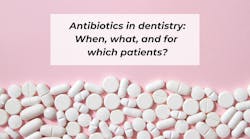World Antimicrobial Resistance Week highlights the need for responsible oral disease treatments
A recent study published in The Lancet estimates that, if no strong actions are taken, 39 million people worldwide could die due to antibiotic resistance between now and 2050.1 This would result in more deaths from antibiotic resistance than from cancer, according to Charlotta Edlund, professor of microbiology and specialist investigator at the Public Health Agency of Sweden.
World AMR Awareness Week (WAAW), observed annually from November 18–24, highlights the global threat posed by antimicrobial resistance (AMR). Misuse and overuse of antibiotics are key drivers of this growing issue. Innovative oral hygiene methods, such as light-activated therapy, provide a preventive approach to managing oral health and infections. By reducing the spread of oral infections, these methods align with broader health-care efforts to combat AMR and decrease the reliance on antibiotics.
AMR is a major global challenge, health experts warn, and is fueled by several factors. Professor Edlund notes that one of the leading causes is the overprescription and misuse of antibiotics, often for conditions where antibiotics are ineffective, such as viral infections or self-limiting illnesses. Additionally, the use of broad-spectrum antibiotics, when unnecessary, accelerates resistance, as does the global challenge of drug shortages, which forces reliance on second-line treatments with greater potential for resistance development.
The complexity of antibiotic development presents yet another hurdle. “As scientific and economic challenges hamper progress in creating new, effective antibiotic agents, without new treatments, resistance may outpace our ability to combat infections,” Professor Edlund warns.
Antibiotic resistance in dentistry: A unique concern
AMR is a significant concern in dentistry, where antibiotics are frequently prescribed to treat dental infections or as a prophylaxis to prevent the spread of infection. Dentists account for approximately 10% of all antibiotic prescriptions for humans, contributing to the development of antibiotic-resistant bacteria. According to the World Dental Federation (FDI), many of these prescriptions are in fact unnecessary, further exacerbating the problem of antibiotic resistance.2
Professor Edlund highlights that minimizing antibiotics in dentistry involves addressing the underlying causes of infection and prioritizing procedures such as abscess drainage, endodontic treatments, and necessary extractions. She adds that antibiotics should be reserved as a supportive measure, used only when systemic infections are present.
While many countries have national recommendations for antibiotic use in dentistry, many still lack comprehensive guidelines that promote responsible antibiotic use, with some only addressing either antibiotic treatment or prophylaxis. Professor Edlund emphasizes that it is crucial for guidelines to be developed through a rigorous, quality-assured process. However, she points out that simply publishing guidelines is insufficient.
“Guidelines must be thoroughly implemented and accompanied by educational efforts to motivate adherence. Additionally, monitoring prescription behavior and providing feedback to clinicians are the key strategies for improving adherence,” Professor Edlund explains.
Combating antibiotic resistance in dentistry with novel methods
Tommi Pätilä, a cardiac and transplant surgeon at the New Children’s Hospital (HUS) in Helsinki, Finland, emphasizes the importance of limiting antibiotic use in all treatments as new antimicrobial-resistant bacterial strains continue to emerge.3 Given the rise of AMR, there is a growing need for alternative methods to treat and prevent serious infections. For instance, photodynamic therapy (PDT) is expected to play an increasingly important role in medicine.
Unlike traditional antibiotics, antibacterial PDT (aPDT) uses light-activated photosensitizers to produce reactive oxygen species (ROS) that damage bacterial cells. This mechanism makes it difficult for bacteria to develop resistance, studies show. Additionally, PDT has shown effectiveness against antibiotic-resistant strains and offers immediate action compared to the delayed effects of antibiotics.4,5
PDT has been used in dental clinics to treat periodontal infections by targeting and destroying pathogenic bacteria. It can also be applied in root canal treatments to eliminate bacteria within the root canal system. PDT is also used in medicine to detect cancerous changes in oral lesions, treat early and advanced oral cancers, and target bacterial and fungal infections.6,7
“The most promising aspect of the method is the absence of developing bacterial resistance. This is based on a physical phenomenon. So far, no resistance has been detected in large-scale studies," Dr. Pätilä says.
The Lumoral treatment is an innovative solution that allows light-activated therapy to be performed at home, complementing traditional oral hygiene methods such as brushing and flossing. This method combines an antibacterial mouth rinse with a targeted light-activated antibacterial therapy. Together, they work to reduce the buildup of harmful plaque bacteria in the mouth, helping to lower the risk of oral infections such as periodontitis. Lumoral is used in some European and Asian countries but is not yet available in the US.
According to Dr. Pätilä, unlike chlorhexidine (CHX), which is a chemical antiseptic, the Lumoral method operates through a distinct mechanism that reduces the risk of bacteria developing resistance.
CHX is a widely used antiseptic in dental care, but there is growing concern about bacterial resistance. Studies have shown that bacteria such as Klebsiella pneumoniae and Pseudomonas aeruginosa can develop resistance to CHX.8 Resistance to CHX has also been linked to cross-resistance to certain antibiotics, such as colistin.9
“Light-activated antibacterial treatment has a different mode of action that reduces the likelihood of bacteria developing resistance. The ROS generated during aPDT cause oxidative damage to bacterial cells, a process that bacteria find challenging to resist. Therefore, Lumoral treatment offers an effective antibacterial approach with a lower risk of contributing to AMR compared to traditional chemical antiseptics like CHX.”
Toward a more preventive approach in dentistry
Studies show that as many as half of the world’s total population over age 30 may suffer from some form of periodontal disease.10 If left untreated, periodontitis can lead to tooth loss and is associated with severe systemic health issues, including an increased risk of heart attack and stroke.11
“Contrary to popular belief, a toothbrush can only remove about 60% of oral biofilm. No wonder caries and gingivitis are the most common diseases in the world. If we want to improve oral health outcomes, we need to address the plaque left behind by tooth brushing, says Timo Sorsa, professor at the department of oral and maxillofacial diseases at the University of Helsinki.
According to Professor Sorsa, the prevention and early diagnosis of periodontal disease offer long-term benefits for patients, public health, and the economy. New diagnostic and treatment methods are now revolutionizing the field of dentistry, making these goals more achievable. Professor Sorsa describes novel antibacterial treatments as a “drug-free alternative” for treating and preventing severe gum disease.
“Antibacterial Lumoral treatment enhances the effect of toothbrushing and plays a key role in managing periodontitis by reducing plaque and balancing harmful bacteria within it. When administered regularly, the treatment specifically targets and reduces anaerobic bacteria, which are often the primary culprits in periodontal diseases. This approach lowers the risk of periodontitis, peri-implantitis, and even dental caries,” explains Professor Sorsa. “By decreasing these risks, patients are less likely to require drugs traditionally used to treat gum disease, such as antibiotics and chlorhexidine. This helps also reduce the risk of antibiotic resistance and associated side effects.”
The professor stresses that the goal of periodontal treatment should focus on long-term health maintenance and prevention, rather than relying on antibiotics, which are intended for treating systemic infections rather than dental issues. Dental hygiene and preventive care are key to reducing the need for antibiotics. For patients with systemic health risks, such as susceptibility to infective endocarditis, preventive dental care is particularly crucial in avoiding serious infections and complications.
Education is also important to lessening the dependency on antibiotics around the globe. A greater global effort is required to ensure dental professionals understand when antibiotics are truly necessary.
“Antibiotic use in periodontitis treatment should primarily be reserved for severe cases, especially when there’s visible pus. That’s when antibiotics are truly indicated. Otherwise, using antibiotics should be avoided to prevent the development of dangerous resistance.”
Editor’s note: This article first appeared in Clinical Insights newsletter, a publication of the Endeavor Business Media Dental Group. Read more articles and subscribe.
References
- GBD 2021 Antimicrobial Resistance Collaborators. Global burden of bacterial antimicrobial resistance 1990–2021: a systematic analysis with forecasts to 2050. Lancet. 2024;404(10459):1199-1226. doi:10.1016/S0140-6736(24)01867-1
- Preventing AMR and infections. FDI World Dental Federation. https://www.fdiworlddental.org/preventing-amr-and-infections
- Causes of antimicrobial (drug) resistance. NIH National Institute of Allergy and Infectious Diseases. https://www.niaid.nih.gov/research/antimicrobial-resistance-causes
- Correia JH, Rodrigues JA, Pimenta S, Dong T, Yang Z. Photodynamic therapy review: principles, photosensitizers, applications, and future directions. Pharmaceutics. 2021;13(9):1332. doi:10.3390/pharmaceutics13091332
- Gilaberte Y, Rezusta A, Juarranz A, Hamblin MR. Editorial: antimicrobial photodynamic therapy: a new paradigm in the fight against infections. Front Med (Lausanne). 2021;8:788888. doi:10.3389/fmed.2021.788888
- Gursoy H, Ozcakir-Tomruk C, Tanalp J, Yilmaz S. Photodynamic therapy in dentistry: a literature review. Clin Oral Investig. 2013;17(4):1113-1125. doi:10.1007/s00784-012-0845-7
- Stájer A, Kajári S, Gajdács M, Musah-Eroje A, Baráth Z. Utility of photodynamic therapy in dentistry: current concepts. Dent J (Basel). 2020;8(2):43. doi:10.3390/dj8020043
- Cieplik F, Jakubovics NS, Buchalla W, Maisch T, Hellwig E, Al-Ahmad A. Resistance toward chlorhexidine in oral bacteria – is there cause for concern? Front Microbiol. 2019;10:587. doi:10.3389/fmicb.2019.00587
- Wand ME, Bock LJ, Bonney LC, Sutton JM. 2017. Mechanisms of increased resistance to chlorhexidine and cross-resistance to colistin following exposure of Klebsiella pneumoniae clinical isolates to chlorhexidine. Antimicrob Agents Chemother. 2016;61(1):e01162-16. doi:10.1128/AAC.01162-16
- Nazir M, Al-Ansari A, Al-Khalifa K, Alhareky M, Gaffar B, Almas K. Global prevalence of periodontal disease and lack of its surveillance. ScientificWorldJournal. 2020;2020:2146160. doi:10.1155/2020/2146160
- Gao Y, Lin H, Luo Y, et al. Nanomaterial-based photodynamic therapy for antibacterial applications: a comprehensive review. Front Mater. 2023;10:1260887. doi:10.3389/fmats.2023.1260887
About the Author

Nina Garlo-Melkas, MSc
Nina Garlo-Melkas, MSc, is a health and science journalist.



